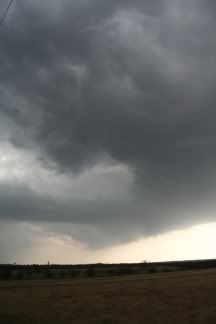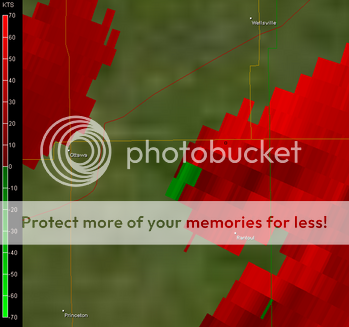Was just curious about some of the things others noticed concerning the structure of the storms on Sunday. One thing I noticed was the lack of anvils for the most part - is this a product of the cold environment aloft? - Dan Chaffee's photo of the Sedalia megastorm really shows what most all of the storms looked like as far as upper structure is concerned. It's interesting because they had such intense, perfectly defined cores on radar, but I'm thinking the tops didn't really push that high.
[/b]
A couple of comments:
As Glen mentioned, the significant, longer lived storms definitely had anvils. They were blown
downwind before they had a chance to expand outward near the updrafts. This, in my experience
is not at all unusual for early Spring storm environments with very strong mid and upper level
winds and lower equalibrium levels (tropopausal heights) --see the pic below
that shows a segment of the anvil the Pettis Co cell and the updraft/anvil of the supercell
to its N. Since an anvil is essentually where the condenstation has no reason to rise
any further (excepting directly over the strongest part of the updraft), it must either
spread out along and underneath the equalibrium level and overturn ('knuckles") or
be blown out of the way at a greater rate than the lifted condensation can expand to replace it.
The latter seems more the senareo in this instance. As with most aspects of storm morphology
there are multiple factors that determine how any part of the storm appears, so it probably
isn't just the speed of the upper winds, but I'll bet that played a big part.
The storm I showed yesterday (Pettis Co at the time) started to backshear its anvil a few
minutes after I headed back. Around the updraft, he anvil was amazingly thick--about
10,000 to 15,000 ft thick (or more!) and purely cumuliform along its western and southern
edges. The morphology of this storm was somewhat different than what I saw at the southern
end of the convection entering the SW KC metro area at 2:20pm CST, where the updraft was
highly sheared over, more than 45 deg from the vertical. The longer lived storms had more
robust, nearly vertical developement as they matured.
I recall another storm back in 1995--the "I-70 Supercell" that had a surprisingly
wispy anvil near the updraft at times, during its long lasting mature phase, with it looking
broader considerably further downwind. The winds aloft were fierce with that event as well.





